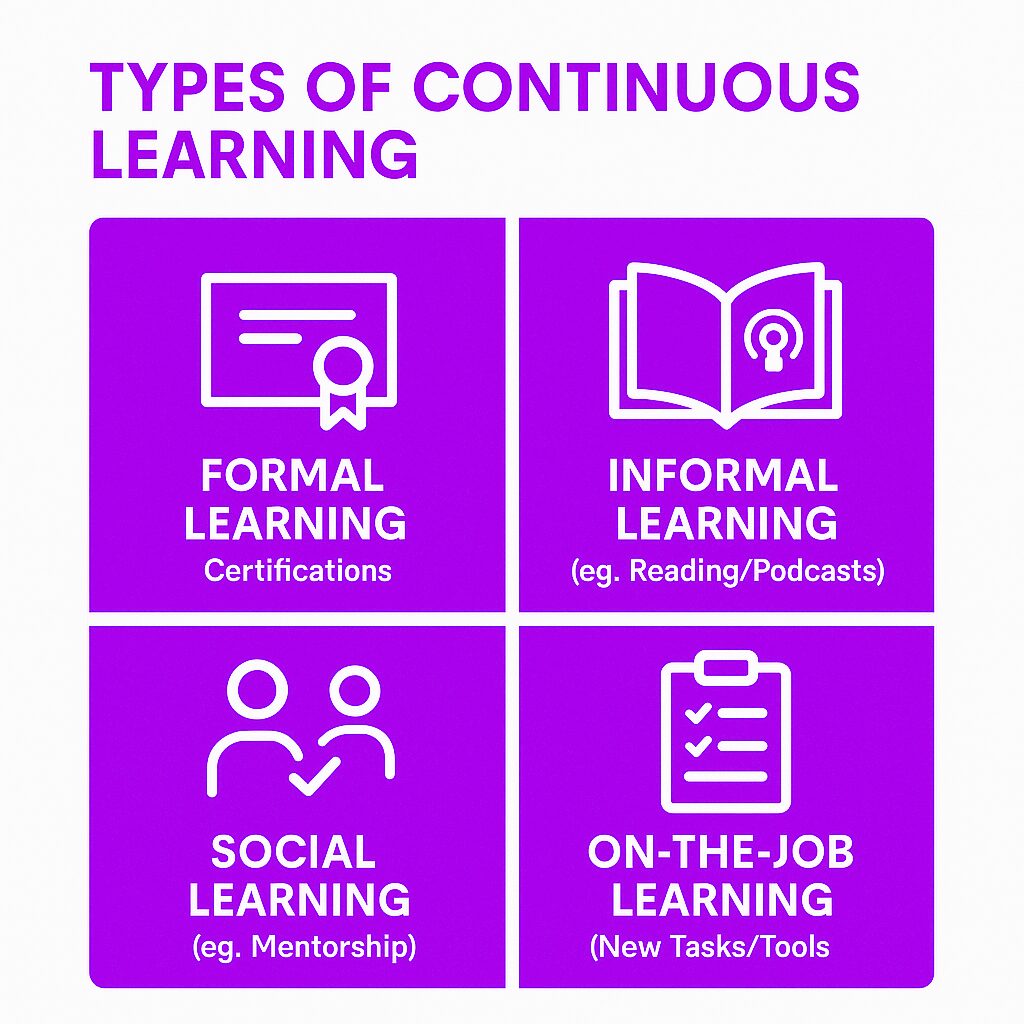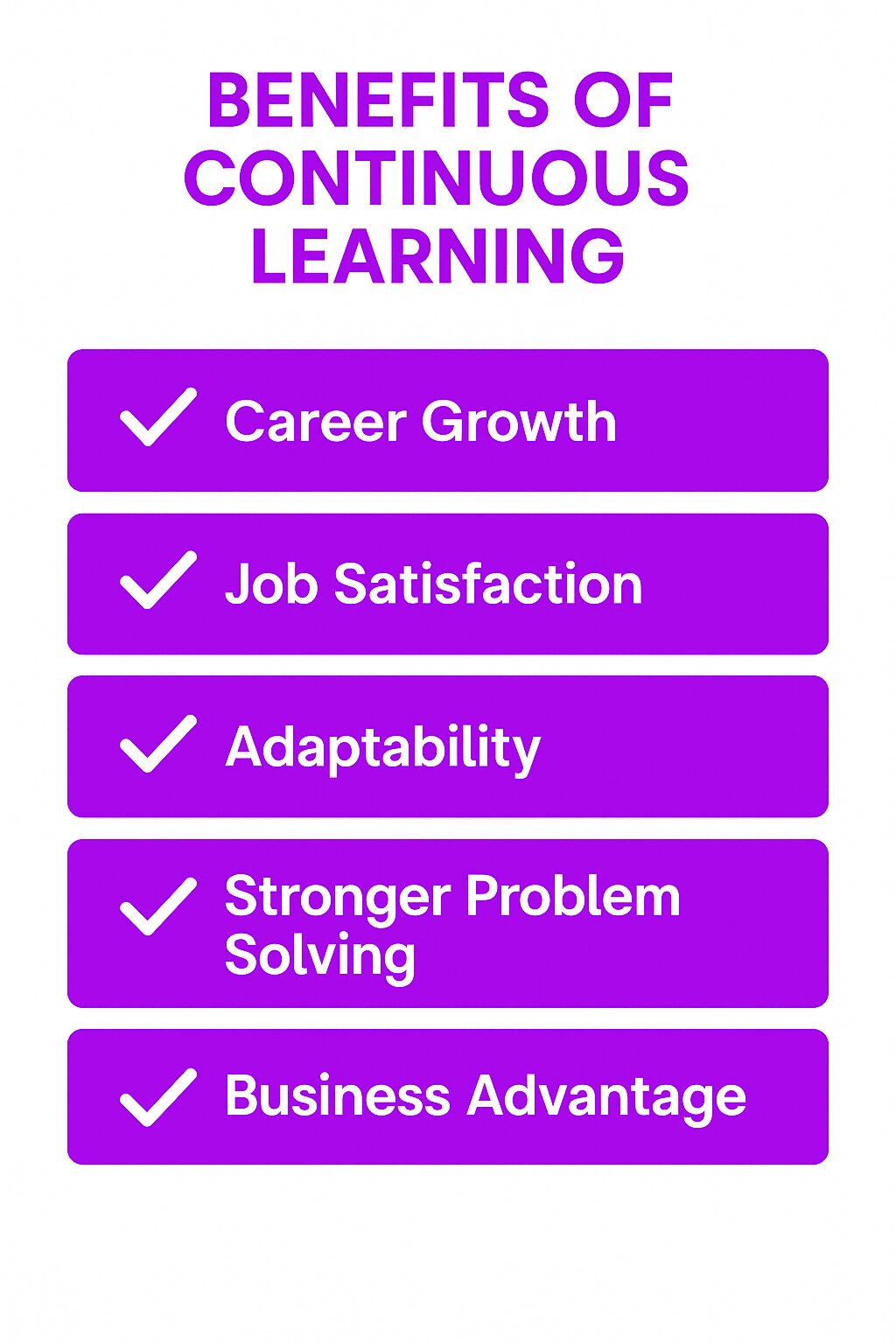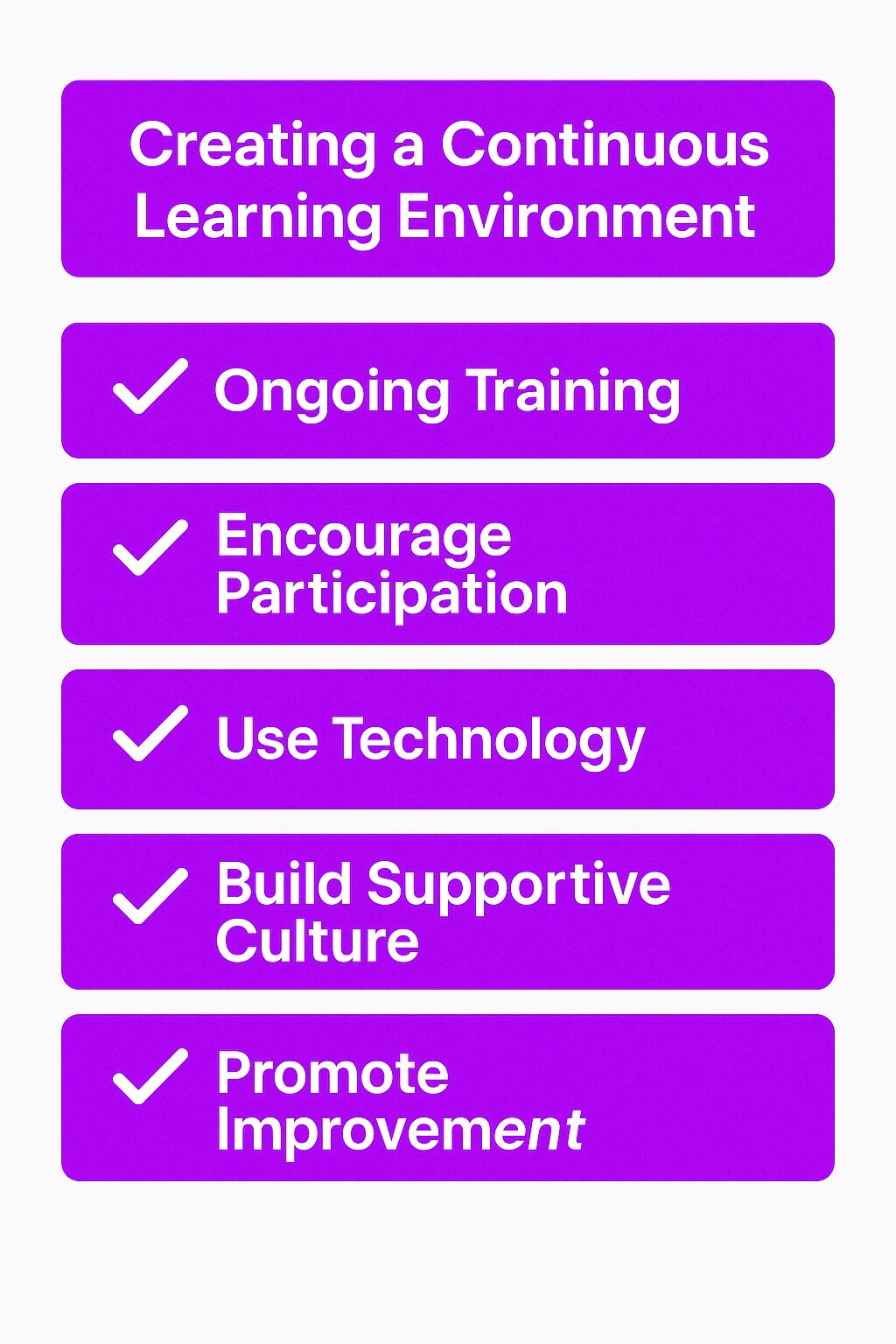What is Continuous Learning?
How continuous learning is an ongoing process of acquiring new skills and knowledge that adapts to both personal development and the changing needs of the industry. It extends beyond formal education and continues throughout life. It happens in workplaces, through personal experiences, and in everyday interactions. Unlike traditional learning, which often stops after schooling, continuous learning is an ongoing commitment.
People learn continuously through reading, online courses, workplace training, mentorship, and real-world problem-solving. Businesses embrace continuous learning to stay competitive, adapt to industry changes, and keep employees engaged. Technology, career demands, and rapid innovation make continuous learning a necessity rather than an option.
Why Continuous Learning Matters
Change is constant. Industries evolve, technologies advance, and new skills become essential. Without continuous learning, individuals and businesses fall behind. Continuous learning benefits both individuals and organizations by fostering employee growth and improving team morale. Learning keeps people relevant, adaptable, and capable of handling new challenges.
For individuals, continuous learning leads to better career prospects, personal development, and job security. Employees who learn regularly are more confident, productive, and prepared for new roles. Companies that encourage learning benefit from higher retention, improved problem-solving, and a workforce that adapts quickly to change.
Continuous learning also promotes curiosity. People who make learning a habit seek out new information, explore different perspectives, and develop innovative solutions. It fosters growth in both professional and personal settings.
Key Components of Continuous Learning
Formal Learning
Formal learning follows structured programs. This includes higher education, professional certifications, corporate training, and workshops. It is usually planned, goal-oriented, and led by instructors.
Examples:
-
College degrees
-
Professional certifications (PMP, AWS, Six Sigma, etc.)
-
Leadership and management training programs
Formal learning fits into a continuous learning strategy by providing structured programs that support ongoing employee development.
Informal Learning
Informal learning happens outside structured settings. It includes self-directed learning, experiences, and observation. It is flexible and often spontaneous. Informal learning contributes to a continuous learning mindset by encouraging individuals to seek knowledge through flexible and spontaneous methods.
Examples:
-
Reading books and articles
-
Watching educational videos
-
Listening to industry podcasts
-
Learning from colleagues
Social Learning
Social learning occurs through interactions with others. It includes mentorship, networking, and collaborative projects. People learn by observing, discussing, and working with others.
Examples:
-
Peer learning groups
-
Professional networking events
-
Shadowing experienced colleagues
-
Joining industry forums and online communities
On-the-Job Learning
Work experience is a key source of continuous learning. Employees gain skills by solving real problems, taking on new responsibilities, and adapting to workplace demands. On-the-job learning significantly contributes to career development by providing employees with opportunities to gain new skills and take on new responsibilities.
Examples:
-
Learning new software through daily use
-
Cross-training in different departments
-
Handling challenging projects
-
Taking on leadership roles
Technology-Driven Learning
Digital tools make learning more accessible. Online courses, virtual reality (VR) simulations, and AI-driven platforms allow people to learn at their own pace.
Examples:
-
E-learning platforms like Coursera and Udemy
-
AI-powered training programs
-
Mobile learning apps
-
Virtual simulations for hands-on practice
Benefits of Continuous Learning
Career Growth
Employers value employees who develop new skills. Continuous learning is crucial for employee career development as it improves job security, opens doors to promotions, and increases earning potential. Professionals who stay updated with industry trends remain in demand.
Increased Job Satisfaction
Learning keeps work engaging. Employees who gain new skills feel more confident and capable. This leads to higher motivation, productivity, and job satisfaction.
Adaptability
Industries change. Technology disrupts workflows. Continuous learners adjust quickly, take on new roles, and remain valuable. Adaptable employees drive business success.
Stronger Problem-Solving Skills
Learning broadens perspectives. Exposure to new information and ideas improves critical thinking and decision-making. Employees who learn continuously tackle challenges with creative solutions.
Competitive Advantage for Businesses
Organizations that prioritize learning stay ahead. Skilled employees contribute to innovation, efficiency, and better customer service. Continuous learning fosters a culture of improvement, making businesses more resilient to change.
Challenges of Continuous Learning
Time Constraints
Busy schedules make learning difficult. Employees struggle to balance work, personal life, and education. Businesses must provide time and resources to support learning.
Resistance to Change
People are comfortable with familiar methods. Adopting new skills requires effort and mindset shifts. Organizations need to encourage and reward learning behaviors. Implementing continuous learning as a strategy can help overcome resistance to change by fostering a workplace culture that prioritizes feedback and coaching, ultimately enhancing employee performance and knowledge retention.
Cost
Some learning programs are expensive. Certifications, workshops, and online courses may not always be affordable. Companies can invest in cost-effective solutions like mentorship, peer learning, and internal training.
Information Overload
With abundant learning resources, it’s easy to get overwhelmed. Filtering relevant, high-quality content is a challenge. Learners need to set goals and prioritize key areas of development.
Creating a Continuous Learning Environment
Creating a continuous learning environment is essential for organizations to stay competitive in today’s fast-paced business landscape. A continuous learning environment encourages employees to prioritize ongoing learning and improvement, leading to increased employee engagement, motivation, and productivity. To create a continuous learning environment, organizations can implement the following strategies:
-
Provide Ongoing Training and Development Opportunities: Regularly offer workshops, seminars, and online courses that align with employees’ career goals and the company’s objectives. This ensures that learning is continuous and relevant.
-
Encourage Employee Participation and Engagement: Foster a culture where employees feel motivated to take part in learning activities. Recognize and reward those who actively pursue professional development.
-
Use Technology to Support Learning: Leverage e-learning platforms, mobile apps, and AI-driven tools to make learning accessible and flexible. Technology can provide personalized learning experiences that cater to individual needs.
-
Create a Supportive Learning Culture: Promote a culture where learning is valued and supported at all levels of the organization. Encourage knowledge sharing and collaboration among employees.
-
Foster a Culture of Continuous Improvement: Encourage employees to seek out new skills and knowledge continuously. Implement feedback mechanisms to help employees identify areas for improvement and track their progress.
A continuous learning environment can be achieved by providing employees with the tools, time, and motivation to make learning a self-directed priority. This can be done by offering flexible, on-demand, and continual learning opportunities that cater to different learning needs and goals.
The Role of Artificial Intelligence in Continuous Learning
Artificial intelligence (AI) is playing an increasingly important role in continuous learning. AI can help organizations create personalized learning experiences for employees, provide real-time feedback and assessment, and identify knowledge gaps. AI-powered learning platforms can also help organizations track employee learning and development, providing insights into learning behavior and outcomes.
AI can also help organizations create a continuous learning culture by providing employees with access to relevant and timely learning content. AI-powered chatbots and virtual assistants can provide employees with learning recommendations and support, helping them to stay on track with their learning goals.
Overall, AI has the potential to revolutionize continuous learning by providing organizations with the tools and insights they need to create a culture of ongoing learning and improvement. By leveraging AI, organizations can improve employee engagement, motivation, and productivity, leading to better business outcomes.
Practical Strategies for Continuous Learning
Set Learning Goals
Identify key skills to develop. Set clear, realistic goals. Track progress and adjust learning plans based on needs.
Schedule Learning Time
Block dedicated time for learning. Whether it’s daily reading, weekly online courses, or attending workshops, consistency is key.
Use Multiple Learning Methods
Combine formal and informal learning to acquire a new skill. Read books, watch tutorials, engage in discussions, and apply new knowledge in real situations.
Leverage Technology
Utilize e-learning platforms, mobile apps, and AI-driven tools. Online courses and digital resources make learning more accessible and flexible.
Participate in Professional Networks
Join industry groups, attend conferences, and engage in online communities. Learning from peers and mentors accelerates growth.
Encourage Learning in the Workplace
Businesses should foster a culture of learning. This includes offering training programs, mentoring, and knowledge-sharing initiatives. Fostering a culture of learning in the workplace contributes to personal and professional growth by supporting employees’ continuous development.
Real-World Examples of Continuous Learning
Corporate Training Programs
Companies like Amazon and Google provide continuous learning opportunities through internal training programs. Employees can take courses, earn certifications, and upskill regularly.
Technology Industry
Tech professionals must keep up with programming languages, cybersecurity, and AI advancements. Learning new coding frameworks or cloud platforms ensures career longevity.
Healthcare Sector
Doctors, nurses, and healthcare workers need continuous education to stay updated on medical advancements, treatment protocols, and emerging diseases.
Education Field
Teachers adapt to new teaching methods, digital tools, and curriculum changes. Professional development programs help educators enhance their teaching skills.
Related Concepts
Lifelong Learning
Lifelong learning is broader than continuous learning. It includes personal interests, hobbies, and general knowledge, not just career-related education.
Constant Learning
Constant learning implies non-stop education, but it often lacks the structure and purpose of continuous learning. Continuous learning is more intentional and goal-oriented.
Continual Learning
Continual learning refers to learning in phases or cycles. Unlike continuous learning, which is ongoing, continual learning may involve periods of intense education followed by application.
Final Thoughts
Continuous learning is essential in today’s world. It helps individuals grow, businesses stay competitive, and industries evolve. Those who make learning a habit gain confidence, adaptability, and long-term success. Whether through formal education, self-study, or hands-on experience, learning should never stop.







